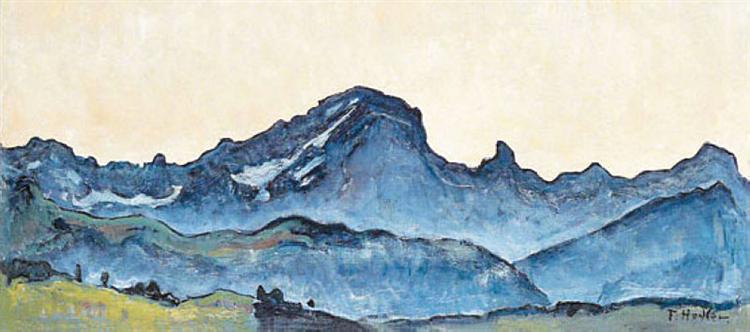Description
Ferdinand Hodler's "great muveran", made in 1912, is erected as an eloquent testimony of its author's artistic virtuosity and its deep connection with the Swiss nature. Hodler, born in Bern in 1853, is recognized by his unique style that amalgamous characteristics of symbolism, realism and a particular rhythmic repetition technique known as "parallelism" that he himself developed. The latter becomes a distinctive firm that permeates many of its landscape works, including "great muveran".
At first glance, the painting "great muveran" surprises with its monumentality and serenity. The Muveran mountain, part of the Swiss Alps, stands imposing in the center of the composition with an austere magnificence that catches the look. Hodler uses a chromatic palette that travels from the terrible tones of the mountain base to the white and black blue of the snowy peaks and the sky. This colored gradation not only provides depth, but also circumscribes the work within a meditated spatial balance.
The verticality of the mountain is counteracted by the horizontal disposition of the horizon and the sky, creating a compositional duality that highlights the drama and stability of the landscape. The precise and delineated contours of the rock formations are characteristic of Hodler's style, who is distinguished by its ability to capture the mythical essence and static greatness of the alpine terrain. This approach is not merely documentary; Through its interpretation, Hodler raises the landscape to the category of the sublime, evoking a feeling of the eternal and the immutable.
There is no human presence in the scene, which is a deliberate decision by the author that amplifies the impression of loneliness and natural grandiosity. The absence of characters underlines the idea of the landscape as an autonomous and powerful entity, independent of human intervention. It is an ode to nature in its pure state, in which the mountain, with its majestic silhouette, seems to tell its own history without the need for human intermediaries.
The light in "Great Muveran" is another subtle but definitive protagonist. Hodler masterfully plays with lighting to confer volume and realism to rock formations, insinuating the time of day nearby at sunset, when the shadows begin to lengthen and the sunlight acquires a golden hue. This use of light also contributes to a feeling of tranquility and contemplation, inviting the viewer to a visual meditation on the beauty of the Alpine landscape.
The year 1912, when this painting was created, it was a vital period in Hodler's artistic production, who had already reached both technical and conceptual maturity. "Great Muveran" thus enrolls in a phase in which the artist seeks to capture not only the physical appearance of landscapes, but also their emotional and spiritual dimension. This work, together with others from the same era, reflects Hodler's continuous evolution towards a visual synthesis that combines detailed precision and emotional expressiveness.
In conclusion, "Gran Muvran" is an essential piece to understand the artistic legacy of Ferdinand Hodler and its unique ability to portray the essence of Swiss landscapes. Through its domain of composition, color and light, Hodler offers us an image that transcends the merely visual to become a meditation on nature and eternity.
KUADROS ©, a famous paint on your wall.
Hand-made oil painting reproductions, with the quality of professional artists and the distinctive seal of KUADROS ©.
Art reproduction service with satisfaction guarantee. If you are not completely satisfied with the replica of your painting, we refund your money 100%.

